Origins
From the earliest times of the Roman Republic until the fifth to fourth centuries BC, the Roman economy functioned on a system of barter in which cattle were used as a means of exchange. Around the fifth century BC, or even earlier, lumps of bronze called Aes Rude came to be used as money since they could be used to produce tools and weapons. The lumps consisted mostly of copper with a small amount of tin. These lumps of bronze eventually graduated to bars of cast bronze known as Aes Signatum and cast coins called Aes Grave which date from about 269 BC. These pieces (at times weighing almost a pound) were cast in a two-piece mould made of either steatite or baked clay inlaid with some form of carbon to produce a smooth surface. These moulds consisted of carvings of exotic animals or gods with the ship’s prow eventually becoming a common feature. Vents were incorporated into the moulds to prevent the bronze from blistering.
The Romans no doubt found these large pieces of bronze cumbersome and inefficient to use. Thus, during the mid-third century BC, Roman moneyers were obligated to develop a new coinage that would accommodate for the complexity of the growing Roman economy. Since the Greeks had been experienced in producing coinage since the seventh century BC, the Romans brought Greek workers from the mints of Southern Italy (also known as Magna Graecia or “Great Greece”) to develop a silver currency. As a result, a number of coin types commonly found on Greek coins made their way onto the faces of Roman coins.
Roman Coins
Gaius Octavius, the future emperor Augustus, was born on September 23, 63 BC. He was the great-nephew of Julius Caesar and was adopted as Caesar’s son. In 43 BC, after gaining the consulship, Octavian entered into an agreement with his rivals in power, Marcus Antonius and Marcus Aemilius Lepidus, known as the Second Triumvirate. In 42 BC, the triumvirs avenged the murder of Caesar by defeating the assassins Brutus and Cassius at the Battle of Philippi. Julius Caesar was deified in this year. From this point on, Octavian came to be known as divi filius, “son of the Divine (Julius).”
Soon the Second Triumvirate began to deteriorate. Octavian defeated Antony at the Battle of Actium in 31 BC and assumed supreme power in Rome. In January of 27 BC, Octavian received the honorific title of “Augustus” which proclaimed his superior position in the state. In 23 BC he received proconsular imperium (powers as commander-in-chief of military forces) and the tribunician power for life, which were seen as the definitive powers of his supreme authority as emperor of the Roman Empire.
The reign of Augustus was generally a stable and prosperous one. Augustus died in AD 14, at which point the Senate decreed that Augustus should be included among the gods of the state. Augustus was thereafter known and revered for bringing peace and good fortune to the Roman Empire.
(See also: Ara Pacis Augustae; Livia; Gaius or Lucius Caesar.)
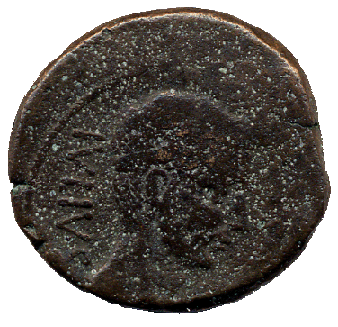
Head of Octavian r.; before CAESAR; after DIVI F downwards.

Wreathed head of Julius Caesar r.; before DIVOS (or DIVVS) downward; behind IVLIVS downward.
Marcus Julius Agrippa (referred to as “Herod” in the biblical Acts of the Apostles) was a grandson of Herod the Great, who sent Agrippa to grow up at the Emperor Tiberius’ court in Rome. Agrippa’s return home to Idumaea in the east in AD 23 was not a success, and he returned to Rome, only to be accused of treason by Tiberius. However, he had befriended the future emperor Caligula, and upon Tiberius’ death, Caligula cleared Agrippa of the charges and made him a provincial governor. Caligula was murdered in AD 41, but Agrippa was also a friend of the new emperor, Claudius. Claudius granted Agrippa jurisdiction over still more provinces, including Judaea and Samaria. Agrippa now controlled a far greater territory than that of his grandfather and had become a extraordinarily powerful prince.
Accounts of Agrippa’s reign are generally favourable. He was enthusiastic about the Jewish faith and even stood up to Caligula, persuading the emperor not to put a statue of himself in Jerusalem’s temple. However, his power and influence in the east caused Claudius some worry, and Agrippa’s kingdom was absorbed back into the empire after his sudden death in AD 44.

Canopy with fringe; around BASILEW[S AGRIPPA] with border of dots.

3 ears of barley issuing from between two leaves; across field, date; border of dots.
Civil Wars: 68-69 AD
Coins of Galba
Roman Emperor (June AD 68 - January AD 69)Servius Sulpicius Galba was declared emperor by the Praetorian Guard in June AD 68 after having been invited by Vindex, the governor of Gallia Lugdunensis, to replace Nero. Galba took the title of Caesar and along with Otho, the governor of Lusitania, marched towards Rome and entered the city in October to assume his new position. Galba experienced threats from others who had also rose in revolt against Nero and wanted a share in the powers of Rome for themselves. These men were Nymphidias Sabinus, who professed himself to be the son of the emperor Gaius and therefore had a claim to the principate, and Clodius Macer, who refused to recognize Galba and decided to raise his own legion. Galba had both men executed.
Galba had the reputation for being an honest, but suspicious administrator. However, Galba’s reign did not lost long. He failed to pay the donative he had promised to the soldiers, offending and angering them. He also offended Otho by having Lucius Calpurnius Piso adopted as his successor. The soldiers on the Rhine rose up against him in January AD 69 and Otho organized a conspiracy against him among members of the Praetorian Guard, who murdered him.
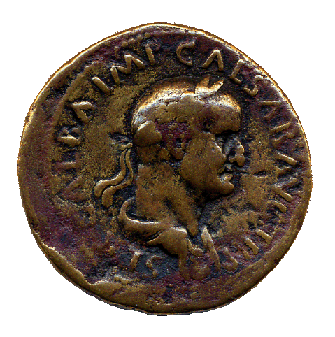
Laureate head of the emperor Galba, facing right. SER GALBA IMP CAESAR AVG TR P
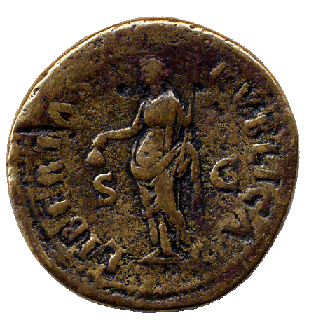
The goddess Liberty standing, facing right holding a pileus in her right hand and sceptre in her left hand. To the left and right S C on the perimeter LIBERTAS PVBLICA
Adoptive and Antonine Emperors
Marcus Ulpius Nerva Traianus, commonly called Trajan, was governor in Germany when he heard the news that he had been adopted by the emperor Nerva as his successor. Upon Nerva’s death in AD 98, Trajan assumed the position of emperor. He was well liked in Rome, but spent most of his time on the frontiers maintaining and expanding the borders of the Empire. He was known as a natural leader who did not abuse his powers and insisted on traditional ways of governing the empire. He ensured that the alimenta relief program initiated by Nerva was carried out. He instigated an extensive program of public works, which included road construction, new baths, the Aqua Traiana (Trajan Aquaduct), and the Forum of Trajan. He carefully chose those who would govern the provinces and relieved some of the financial burdens placed on people there as well as making more provincials members of the Senate.
Yet Trajan was a military leader at heart and spent much of his time campaigning and curbing revolts on the frontiers of the Roman Empire. He was given the names Dacius, Parthicus and Optimus in honor of his victories. Eventually, Trajan left his military affairs to his generals and decided to go back to Rome. However, he died en route, in Selinus, in August of 117. His ashes were placed in the base of his column in his Forum and he was thereafter deified.
(See also: Trajan.)
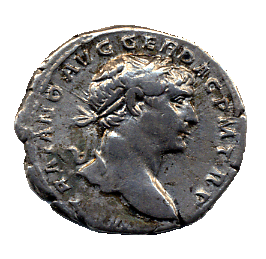
Bust of Trajan laureate. [IMP] TRAIANO AVG GER DAC PM TRP
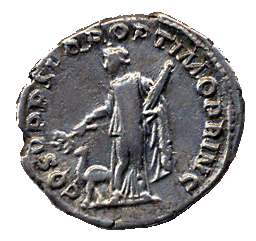
Arabia draped, standing l. holding branch in r. hand over a camel walking l., in l. hand a bundle of canes. COS V PP SPQR OPTIMO PRINC
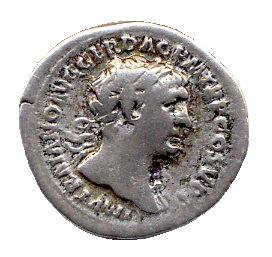
Head of Trajan, laureate r.; encircled by IMP TRAIANO AVG GER DAC P M TR P
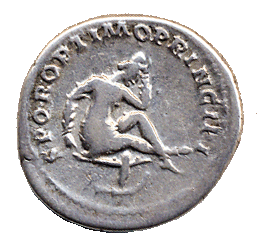
Head of Trajan, laureate r.; encircled by IMP TRAIANO AVG GER DAC P M TR P
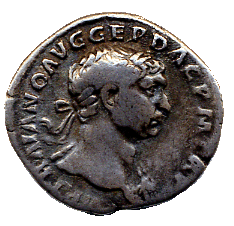
Head of Trajan facing r. IMP TRAIANO AVG GER DAC PM TRP COS V PP
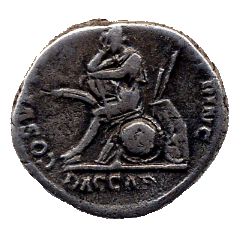
Dacian in peaked hat and long sleeved shirt and breeches seated r. on oblong shield, resting head on l. hand with elbow on knee, l. leg crossed over r. Below, curved sword. SPQR OPTIMO PRINCIPI
Publius Aelius Hadrianus was born in AD 76. He was related to the emperor Trajan through his grandmother Ulpia, Trajan’s aunt. In 85, Hadrian’s father died and Hadrian became the ward of Trajan, who had no children. Hadrian grew up in Trajan’s household and later became a tribune, consul, and governor of Syria. The day after Trajan’s death, Hadrian learned that he had been adopted as Trajan’s son and successor. Immediately, Hadrian was proclaimed emperor by the troops and the Senate in turn recognized his imperial powers.
During his reign, Hadrian toured the provinces to attend to such matters as military organization and defense, administrative coordination, to present himself to provincials as their leader, and to observe the conditions in the provinces. He spent most of the years between 120 and 131 traveling and developing a foreign policy aimed at a peaceful economy and secure frontiers. He also headed developments in administrative policy. He reorganized the army, appointed curatores to supervise local finance in municipal areas, and had laws passed to improve the conditions under which slaves lived.
In 136, Hadrian’s health began to deteriorate. In 138, he adopted Antoninus Pius as his successor, just before his death and consecration.
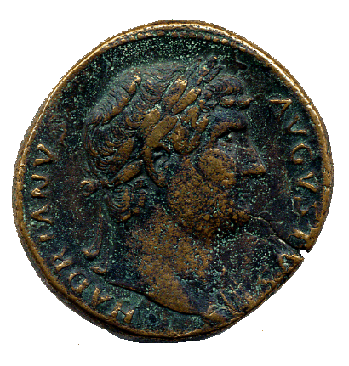
Head of Hadrian laureate HADRIANVS upwards l. AVGVSTVS downwards r.

Aequitas holding scale in r. hand and vertical rod in l. COS upwards l. III downwards r. S C to l. and r. in field.
Antoninus Pius was born Titus Aurelius Fulvus Boionius Antoninus in AD 86 of a consular family. He held a number of magistracies including the consulship and was a member of Hadrian’s advisory council prior to his adoption by Hadrian, who respected Antoninus for his loyalty and gentleness. During the last months of Hadrian’s life when his health was weakening, Antoninus was virtual ruler, holding all of Hadrian’s powers. Upon Hadrian’s death in 138, Antoninus succeeded peacefully to the position of emperor and the Senate granted him the title Pius in honor of Antoninus’ devotedness to his adoptive father, Hadrian, to the state, and the gods.
The reign of Antoninus Pius was a very peaceful one with few changes to the way the empire was governed. He found favor with the Senate by granting them control over Italy and continued to consult an advisory council concerning the affairs of state. He was known as a very generous individual who helped many communities financially and carried out extensive public building. He also cut public expenditure which left the treasury with the most money it had seen in years. Although Antoninus’ reign was known as a time of peace and well-being, instability still occurred in such areas as Numidia, Egypt, Dacia, and Mauretania. Yet these affairs were settled due to Antoninus’ peaceful influence. Antoninus Pius died 7 March 161 and was deified, leaving the empire in the hands of Marcus Aurelius.

Laureate head of Antoninus Pius encircled by ANTONINVS AVG PIVS P P TR P

Salus draped standing l., feeding out of patera in r. hand a snake, coiled round altar l.; holds rudder on globe in l. hand. <S.C>. to l. and r. in field. <COS>upwards l. II? downwards r.
Annia Galeria Faustina Minor was born some time between AD 125 and 130. She was the daughter of emperor Antoninus Pius and empress Faustina the Elder, and grand-niece of the emperor Hadrian. She married her cousin (who was adopted by her father as a son), Marcus Aurelius, in AD 145. She acceded to the throne along with her husband in AD 161.
Interestingly, the extant sources for Faustina the Younger’s life and character indicate that she was cruel and lascivious--ordering executions, stirring up revolts, and committing adultery. However, the sources also indicate that she and Aurelius were very happily married. Faustina accompanied Aurelius on his many military campaigns, and the soldiers, too, are said to have supported and revered her.
Over the course of more than twenty years, Faustina bore thirteen children, most of whom died young. One daughter, Lucilla, married Aurelius’ co-emperor, Verus (to whom Faustina herself had been betrothed before her marriage to Aurelius). Her son Commodus became emperor in AD 180.
Upon Faustina’s death in AD 175, Aurelius buried her in the Mausoleum of Hadrian and deified her. He carried out public works in her name, for example, building baths and opening girls’ schools.
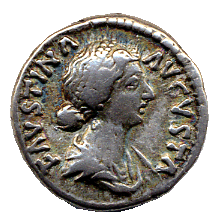
Bust of Faustina draped r. Hair waved and fastened in bun on back of neck on which is draped a string of pearls. FAVSTINA AVGVSTA
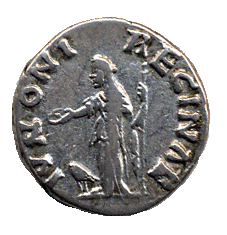
Juno draped standing l. holding patera in r. hand and scepter in l. Peacock in front. IVNONI REGINAE
Marcus Annius Catilius Severus, known as Marcus Aurelius Antoninus upon accession, was born in 121 AD, the son of Annius Verus, the brother of Faustina the Elder, wife of Antoninus Pius. Very early in his life he gained the favor of the emperor Hadrian, who made him a Salian priest when only 8 and supervised his education. He was later adopted by Antoninus Pius and was married to his daughter, Faustina the Younger, in 145. With the birth of their first child in 146, he was designated as Pius’ imperial partner with tribunician and proconsular powers. Aurelius succeeded as emperor in 161. Lucius Verus, who was also adopted by Pius, became emperor alongside Aurelius, who insisted on having him as his colleague.
War dominated the reign of Marcus Aurelius, causing problems throughout the empire and in Rome itself, draining the treasury and making administration difficult. With the death of Verus in 169, Marcus raised his son Commodus as his fellow emperor, giving him the title Augustus, the tribunician power and the proconsular imperium. He left his son to govern Rome while he continued to fight the German tribes in an attempt to secure Rome’s empire from this ever-imposing threat. He died swiftly and peacefully in 180 during his campaign against the Quadi and Iazyges. Marcus Aurelius is remembered best as a Stoic philosopher. He compiled a work called the Meditations which highlighted his high Stoic principles and survives to this day.

Bust of Marcus draped, facing r. [A]VRELIVS CAESAR AVG PII F

Salus draped standing l. with r. hand feeding snake, l. elbow resting on a column. TR POT VIII [CO]S II SC in field.

Head of Faustina the younger (wife of Marcus Aurelius) facing r., hair pulled back in waves in chignon. FAVSTINA upwards l. AVG downwards r.
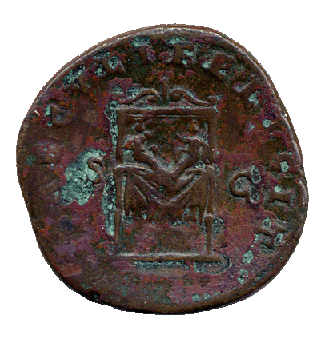
Throne (lectisternium) draped and ornamented with two infant boys seated, facing each other, encircled by <SAE>CVLI FELICIT; S C to l. and r. in field.
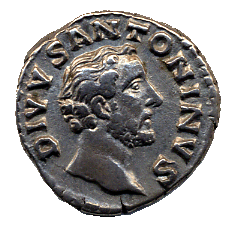
Head of Antoninus Pius bare, r.; encircled by DIVVS ANTONINVS

Pyre of four tiers, decorated with hangings and garlands, surmounted by quadriga; encircled by CONSECRATIO
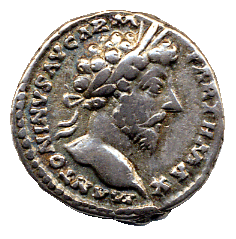
Head of Marcus r., laureate. M ANTONINVS AVG ARM PARTH MAX
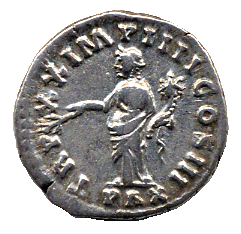
Pax (Peace) draped standing l. holding branch in r. hand and cornucopiae in l. TR P XX IMP IIII COS III PAX

Head of Aurelius laureate r.; encircled by M ANTONINVS AVG ARM PARTH MAX
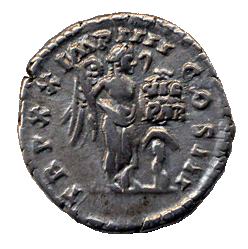
Reverse:
Victory standing front, head r., holding a palm and fixing to a palm tree a shield inscribed VIC PAR; encircled by TR P XX IMP IIII COS III
Lucius Aurelius Commodus was born the son of Marcus Aurelius and Faustina the Younger in 161. During his father’s reign he was continuously advanced until he was made co-emperor to Aurelius in 177 and received the title Augustus. In this same year he married Crispina and accompanied his father in the second German-Samartian War. Commodus succeeded Aurelius as sole emperor upon his father’s death in 180.
Despite maintaining peace on the German frontiers, Commodus was known as a cruel and tyrannical emperor. He replaced members in government with those whom he favored and he required that everything be done according to his will, showing continuous hostility towards the Senate. Commodus’ thirst for power appears to have corrupted his mind since he renamed Rome “Colonia Commodiana” after himself and regarded himself as the incarnation of Hercules. He even went so far as to present himself as both gladiator and consul before the people. This outraged his advisors and provoked them to hire an athlete, Narcissus, to strangle him.

Laureate head of Commodus facing r. encircled by L AVREL COMMODVS AVG TR P V

Jupiter, naked to waist, seated l. on throne holding Victory on r.hand, and vertical sceptre in l. <IOVI VICTORI> upwards l. COS II P P downwards r. S C to l. and r. in field.
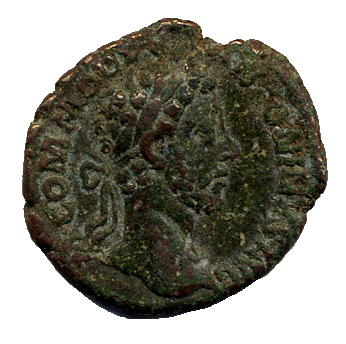
Laureate head of Commodus facing r. encircled by M COMMODVS ANTONINVS AVG
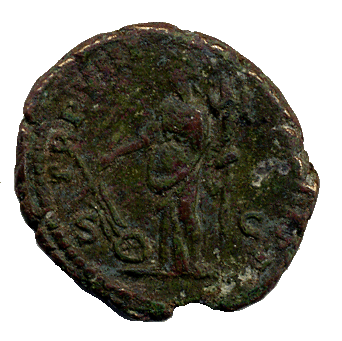
Reverse:
Fortuna standing front, draped, holding rudder on globe in r. hand and cornucopia in l. TR P VIII upwards l. <IMP> VI <COS> <I>III P P downwards r.; S C to l. and r. in field.
Severan
Lucius Septimius Severus was born around 145 of an equestrian family from Lepcis Magna in North Africa. He became emperor in 193 after the death of Pertinax, who was killed for his excessive reforms and strict discipline in the Praetorian Guard. Upon becoming emperor, Severus dismissed the Praetorian Guard and replaced it with a new one that included legionary soldiers. He then set out for the East to eliminate a rival claimant, Pescennius Niger. Upon defeating Niger in 195, Severus now focused on the establishment of a vast dynasty in his name which meant destroying all possible rivals such as Clodius Albinus, governor of Britain. He defeated Albinus at Lugdunum in 197.
Severus replaced many positions in the administration of Roman government with equestrians, which depleted Senatorial power. He confiscated numerous properties in order to cover his pay increase for the soldiers and his campaigns to the East, in which he gained control of Parthia and Mesopotamia. Severus strongly believed in the military basis of imperial power and therefore enriched the military in order to ensure its support. Severus had two sons, Caracalla and Geta. He promoted Caracalla to the rank of Caesar, and Caracalla accompanied his father on many campaigns. Severus, worn out by sickness and the unending rivalry of Caracalla and Geta, died at York in 211.
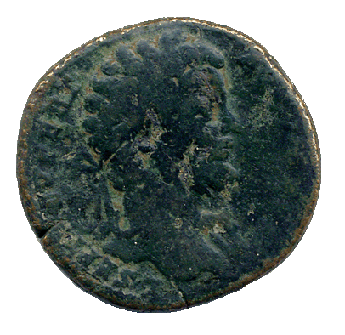
Laureate head Severus facing r. encircled by L SEPT SEV PERT <AVG IMP VII>
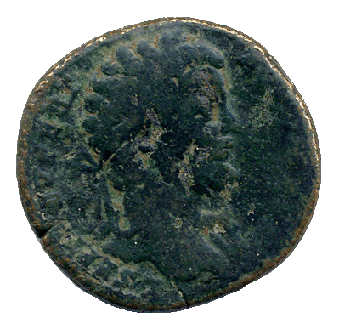
Felicitas standing l. foot on prow, holding caduceus and cornucopia. S C. in field to l. and r. <DIVI M PII F P M TR P III COS II P P>

Bust of Severus laureate r. encircled by L SEPT SEV PER<T> AVG IMP VIIII
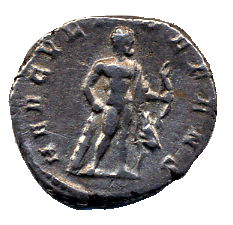
Hercules standing r. resting on club and holding bow in l. hand with lion skin over l. shoulder; HERCVLI upwards l. DEFENS downwards r.
Julia Domna was born in AD 170 to an extremely wealthy Syrian family whose ancestors were priests of Baal. Her family had been awarded Roman citizenship and elevated to the senatorial level. Julia married the future emperor Septimius Severus in 180. She bore him two children, Caracalla and Geta.
Julia and Severus were devoted to each other and shared many intellectual pursuits. Julia is said to have been a patron of scholars such as the renowned physician Galen. She also accompanied her husband on his military campaigns after his accession to the throne; for this, she gained the title mater castrorum (“mother of the camp”).
However, Julia was not universally liked. She was a powerful and political woman, and this garnered her much enmity. Despite her enemies, she functioned as the Empire’s administrator while Severus focused on his many wars. After Severus’ death in AD 211, she attempted to broker peace between their sons, who preferred sole rule instead of the co-emperorship their parents had envisioned. Caracalla had Geta murdered in 212. Despite the obvious strain this put on their relationship, Julia accompanied her remaining son on his campaigns, as she had done for his father. After Caracalla’s assassination in 217, she committed suicide.
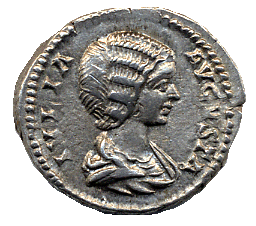
Bust of Julia Domna, draped, head bare, facing r. Hair waved vertically and fastened into large bun on back of head. IVLIA AVGVSTA

Isis wearing polos on head, draped, standing front, head r., left knee on prow of ship. With r. hand baring breast and holding infant Horus on l. arm. Rudder to l. SAECVLI FELICITAS
Marcus Aurelius Antoninus, born Lucius Septimius Bassianus, but famously known by his nickname Caracalla (referring to the Gallic cloak he often wore), was the son of the emperor Septimius Severus and empress Julia Domna. He ruled as co-emperor with his father from 198-211, with his brother Geta from 211-212, and after he brutally murdered his own brother, ruled solely until his death in 217. Caracalla had always had poor relations with his younger brother which his parents had desperately tried to improve--to no avail.
Caracalla’s reign is known for two important political developments: the granting of Roman citizenship to all free men in the Empire and payment of the legions through debasement of silver coinage. Caracalla is particularly infamous for his military zeal; he was the prototype for the “soldier-emperors” who came after him. He pursued campaigns in the West against the German tribes of the Alamanni and the Cenni, and also in the East, where he planned conquests in the fashion of Alexander the Great. He managed to expand the province of Osroene to include Edessa, but failed in an attack against Armenia. While planning a more extensive campaign, he was assassinated near Carrhae in April 217. One of the conspirators, Macrinus, succeeded him.
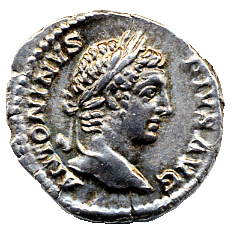
Head of Caracalla facing r., laureate. ANTONINVS PIVS AVG
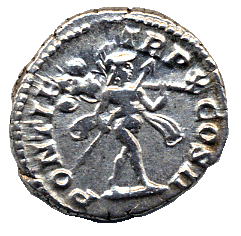
Mars helmeted, naked except for cloak, advancing r. holding spear pointing upwards to r. in r. hand; trophy over l. shoulder in l. hand. PONTIF TRP X COS II
Tetrarchy
Gaius Aurelius Valerius Diocletianus was chosen emperor by the Roman armies in 284. A competent soldier and administrator, Diocletian set out to stabilize the empire, too large and stretched thin by this time for one man to control adequately. Diocletian appointed Maximian as his Caesar in 285, to undertake the administration of Italy and the Western empire. Diocletian was titled Jove (Jupiter) and Maximian was titled Hercules, which reflected their relative status. In 286, Maximian was made co-Augustus, and in 293, in an attempt to stabilize administration and the military needs of the empire further, Diocletian created two Caesars subordinate to the two Augusti, Galerius and Constantius.
In 301, Diocletian introduced his edict on maximum prices which set wage and price controls in an attempt to curb inflation. Penalties for contravention of the edict were severe, and included capital punishment. It was in this year that the legend on follis coinage was changed to Sacra Moneta, stressing the sacredness of the imperial mint. Diocletian cannot be said to have solved the problems of inflation and currency. He did, however, stabilize the frontiers of the empire, and by establishing collegiate rule he ensured that firm government and military control could be undertaken in vital areas of the empire.
Diocletian retired in 305 after over twenty years of rule.

Head of Diocletian, laureate, r., encircled by IMP C DIOCLETIANVS P F AVG
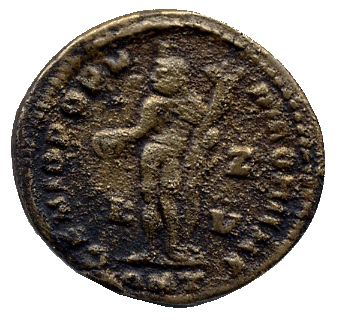
Genius standing holding patera and cornucopiae, encircled by GENIO POPVLI ROMANI. Mint mark Z K V ANT
Marcus Aurelius Valerius Maxentius, born c. AD 278, was the son of Diocletian’s co-emperor Maximian. In AD 305, Diocletian and Maximian handed the Empire over to their Caesars, Constantius Chlorus and Galerius, but the two new Augusti did not appoint Maxentius as one of their own Caesars. Maxentius faded into the background for a time, but when Constantius’ son Constantine was acclaimed as Caesar after his father’s death in 306, Maxentius was ready to accept the same honour. Indeed, the Praetorian Guard in Rome was unhappy with the situation and readily acclaimed Maxentius.
Certain provinces of the Empire recognized Maxentius as emperor, while others remained loyal to Constantine. Galerius did not acknowledge Maxentius as he had recognized Constantine. He attempted to eliminate Maxentius in 307, but his troops betrayed him for Maxentius--and his father Maximinian, who had left his retirement in order to support his son’s claim.
Power swung one way and then the other for almost five years. Maximian even attempted to depose his son, but was defeated in 308. Maxentius’ support had evaporated by AD 312, and, at the Battle of the Mulvian Bridge in that year, Constantine defeated his forces and Maxentius himself was drowned.
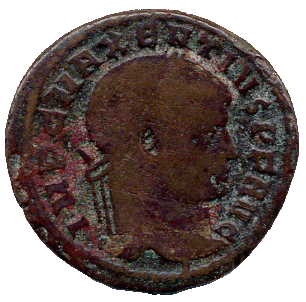
Laureate head of Maxentius r. IMP C MAXENTIVS P F AVG
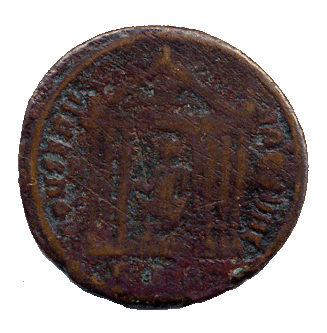
Roma draped, seated front, head l., in hexastyle temple on three steps, holding globe and sceptre, wreath in pediment. CONSERV VRB SVAE
Constantinian
Flavius Valerius Aurelius Constantinus was born in 285, the son of the tetrarch Constantius Chlorus and his concubine Helena. Constantine was kept by Diocletian at his court and showed great promise as an officer. When his father died at York in 306, Constantine was proclaimed emperor by his troops although he was only given the title of Caesar of the West by the emperor Galerius. Maxentius disputed the accession which led to civil war. In 308, Constantine and Daia officially became Augusti and Maxentius was declared a public enemy. Constantine defeated Maxentius at the Battle of Mulvian Bridge in 312, at which point he replaced Daia as the senior Augustus. In 313, Licinius became emperor of the East, ruling with Constantine, but relations between the two were unstable. Civil war once again ensued. By 324, Constantine had forced the abdication and execution of Licinius. Constantine was now sole ruler.
After the defeat of Maxentius, Constantine issued the famous Edict of Milan in 313, which granted complete religious toleration to the empire’s subjects. This edict was a response to Constantine’s conversion to Christianity (although when and if this actually happened is still greatly debated), and his attempt to end the persecution of the Christians in the empire. Constantine I, the Great, is often referred to as the first Christian emperor. Byzantium in the east was transformed to become the new capital of the empire, and renamed Constantinople. Constantine died in 337.
(See also: Constantine the Great.)

Bust of Constantine r., with crested helmet and cuirass, encircled by CONSTANTINVS A<VG>
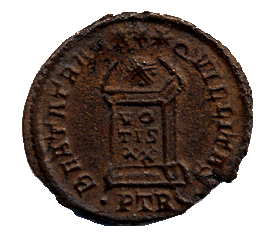
Globe set on cippus inscribed VOTIS XX, three stars above, mint mark (dot) PTR (crescent) below. Encircled by BEATA TRANQVILLITAS
Flavius Iulius Constantius, commonly called Constantius II, was born in AD 317 to Fausta and Constantine the Great. He was their third son. When he was seven years of age, Constantine appointed him as Caesar. Constantine died in 337, when Constantius was twenty years old. Constantine’s will mandated that his three sons split the Empire into three parts. Constantius took control of the East, his elder brother Constantine II controlled the West, and their younger brother Constans took Italy and its neighbouring provinces.
Constantius was occupied for much of his early reign fighting back Persian invaders. But in the West, his brothers had antagonized each other almost immediately, and Constantine II was killed in 340. Constans controlled the West for ten years, until he was killed by the usurper Magnentius. Constantius, eager to gain total control of the empire, moved west to confront Magnentius. Magnentius was soundly defeated at the Battle of Mursa Major in 351 and he committed suicide in 353.
Constantius spent the rest of his reign putting down usurpers--including his relatives Gallus and Julian. During the march to war against Julian, Constantius became seriously ill and decided to sanction Julian as his heir instead. Constantius was baptized a Semi-Arian Christian and died in 361.
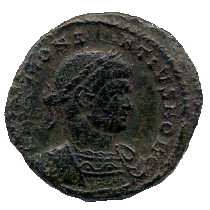
Small bust of Constantius, facing l. laureate and cuirassed, encircled by <FL IVL> CONSTANTIVS NOB C

Two cloaked soldiers standing facing each other; each holding spear, other hand on shield; between, two standards; encircled by GLOR IA EXERC ITVS. Mint mark TR S
Military Emperors
Marcus Julius Verus Philippus was born c. AD 204 in the Roman province of Syria. His father had gained Roman citizenship and was a prestigious figure in the city of Shahba.
Philip rose through the ranks to become Prefect of the Praetorian Guard. While holding this office, however, he conspired in the assassination of the young emperor Gordian III. He took the throne himself in AD 244. Despite this beginning, Philip managed to develop good relations with the Senate. He obtained peace with Persia and defeated the Carpi in 247. The 1000th anniversary of the founding of Rome was celebrated in 248; Philip held an enormous festival with games, plays, gladiatorial fights, and religious ceremonies.
However, the Goths soon invaded Moesia and Decius and the Danubian commander, Decius, was declared emperor in 249 as a result of his popularity with his troops. Philip was thereafter killed in battle at Verona.
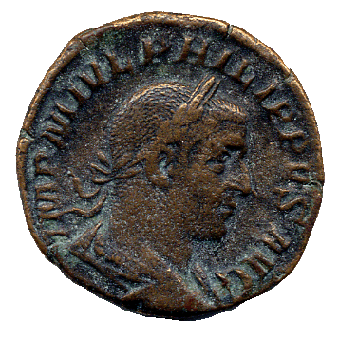
Laureate head of Philip I facing r., shoulders draped, encircled by IMP M IVL PHILIPPVS AVG
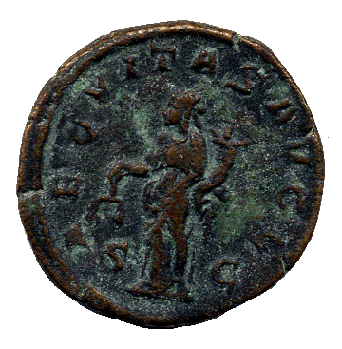
Aequitas standing draped, holding scales in r. hand, cornucopia in l.; encircled by AEQUITAS AVGG; S C to l. and r. in field.
Marcus Julius Philippus Severus was the son of the emperor Philip I and empress Marcia Otacilia Severa. He was born in AD 238 and thus was only six years old when his father appointed him Caesar in AD 244. At nine years of age, his father appointed him consul. The young Philip II’s career did not advance any further, however; when his father was killed in 249, the Praetorian Guard in Rome murdered the boy in his mother’s arms. He was only eleven years old.
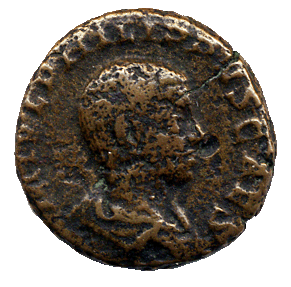
Head of Philip II facing r., shoulders draped. M IVL PHILIPPVS CAES
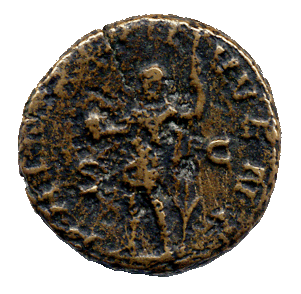
Philip II standing holding globe and standard, encircled by PRIN<CEPS> IVVENT; S C to l and r. in field.
Gaius Vibius Trebonianus Gallus, born to a high-ranking family in AD 206, followed the typical path of the Roman patrician through the imperial offices and became the provincial governor of Moesia Superior in 250. Gallus was victorius in battle against the Goths and was strongly favoured by the troops. He embodied all the characteristics of the “soldier-emperor” with his intimidating bearing and manner. Indeed, the army proclaimed him emperor after Decius’ death in battle in AD 251.
Gallus returned to Rome and made his son, Volusianus, his co-emperor. But the army’s favour was fickle. The soldiers soon proclaimed Aemilianus, the new governor of Moesia Superior, emperor, as he was seen to be more aggressive than Gallus in the war with the Goths. By the time Aemilianus marched into Italy in 253, Gallus and his son had already been murdered by their own soldiers.
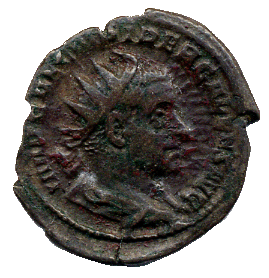
Radiate bust of Gallus, draped and facing r. encircled by IMP <CAE> C VIB TREB GALLVS AVG
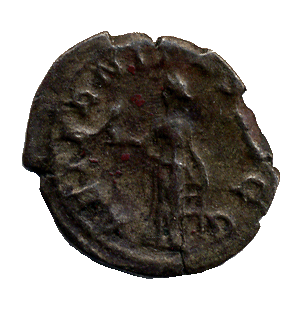
Aeternitas standing l. holding in r. hand a phoenix on globe, l. hand. raising skirt at side; encircled by AETERNITAS <AVG>
Gaius Vibius Volusianus was the son of emperor Trebonianus Gallus and empress Afinia Gemina Baebiana. His father made him co-emperor in AD 251, after the death of the previous emperor’s son had cleared the way. However, Volusianus was killed with his father by their own troops in AD 253, as the army had declared Aemilianus the new emperor.
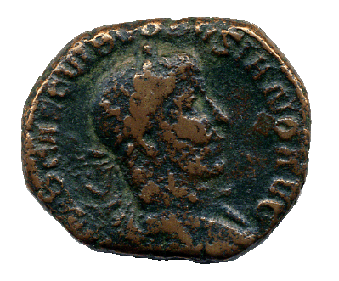
Laureate head of Volusian facing r. encircled by IMP CAE C VIB VOLVSIANO AVG
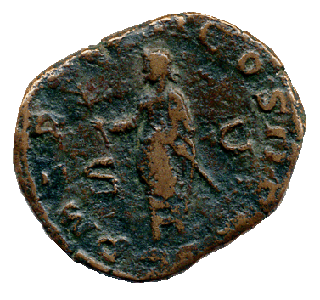
Emperor standing l. holding branch and short transverse sceptre; encircled by P M TR <P> IIII COS II. S C to l. and r. in field.
Publius Licinius Valerianus was born c. AD 200 to a patrician family and was married to Egnatia Mariniana, by whom he had two sons, Egnatius Gallienus and Valerianus Minor. The emperor Decius nominated him as censor, but he refused the post and was instead assigned to govern the provinces of Noricum and Raetia. The next emperor, Trebonianus Gallus, trusted him enough to ask him for reinforcements against Aemilianus, who was attempting to take the throne. However, when both Gallus and Aemilianus were killed by their own troops, nearly the entire army proclaimed Valerian and his eldest son as the next emperors. The Senate was keen to accept this emperor, as Valerian was of their rank.
But Valerian’s reign was thrown into disarray as the provinces began to fall to neighbouring tribes. He divided the empire with his son, giving Gallienus governance of the West while attempting to take control in the East himself. The province of Armenia had been occupied by the Sassanid king Shapur I. Valerian was defeated there at the Battle of Edessa in AD 260, and while attempting to broker peace with Shapur, was betrayed and captured. Shapur imprisoned him until his death.
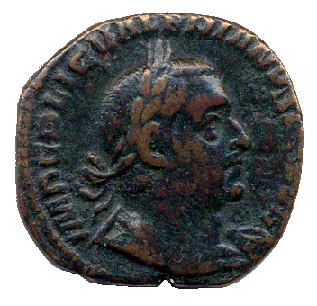
Laureate head of Valerian facing r. encircled by IMP C P LIC VALERIANVS PF AVG
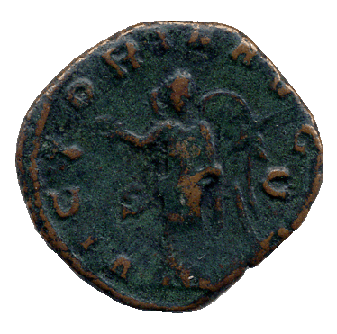
Victory facing front with r. hand holding wreath, l., a palm; encircled by VICTORIA AVG; S C to l. and r. in field.
Roman Emperor (AD 253-268)
Publius Licinius Egnatius Gallienus was co-emperor with his father Valerian from AD 253-260. He governed mostly in the West and prevented some of the Germanic tribes from invading the provinces around the Danube.
Gallienus was born around AD 218 and so was around forty years of age when his father was captured by Shapur I in the East in 260. Gallienus ruled as sole emperor for eight more years, but was constantly threatened by external and internal forces. He faced down revolts led by several of his generals and governors, including Ingenuus and Regalianus. However, the revolt of Postumus in Gaul was successful and Gallienus was forced in 263 to acknowledge Postumus as ruler of the West. By 268, matters were out of control and Gallienus was murdered by his own troops while trying to fight off the threat presented by Aureolus, another would-be usurper.
Gallienus’ three sons were killed by various usurpers and his remaining family were executed by the Senate in 268. However, Gallienus had made some advances during his reign. He gave command to capable men instead of to inexperienced youths of senatorial rank, developed a larger cavalry, and was tolerant of the Christian religion, all acts which helped to preserve what unity the Empire had left.
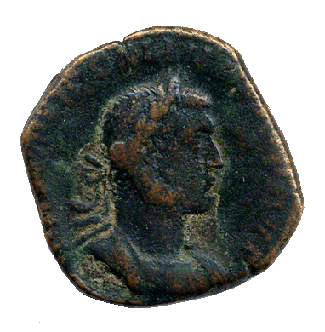
Laureate head of Gallienus facing r., shoulders draped, encircled by <IMP C PVBLIVS LIC GALLIENVS P F AVG>

Liberalitas holding tessera (tablet) and cornucopia., encircled by LIBERALITAS <AVG III?>; S C to l. and r. in field.
Marcus Cassianius Latinius Postumus was one of the generals who rose up against emperor Gallienus around AD 260. Postumus was successful in his revolt and took control of much of the West--what is now France, Spain, Germany and Britain--forming what is known as the Gallic Empire. The region seceded from the Roman Empire and remained independent for fourteen years. It had its own senate, officials and troops.
Postumus himself was killed by a revolt, that of his own army, in AD 268. The Gallic Empire reverted back to the Roman Empire under the control of the emperor Aurelius in AD 274. While Postumus’ actions had severely harmed the unity of the Empire and the authority of the Emperor, he had successfully preserved the Western provinces against invaders.

Bust of Postumus radiate, draped, r.; encircled by <IMP C POSTVMVS> P F AVG

Pax draped, standing l., holding branch in r. hand and transverse sceptre in l. hand; encircled by PA<X AVG>
Marcus Piavonius Victorinus ruled Postumus’ Gallic Empire from AD 268 to AD 270. He had been co-consul with Postumus and, after the death of Postumus (and his successor Marius), was declared emperor by the troops of Gaul and Britain, although Hispania at this time rejoined the Roman Empire.
The secessionist empire Victorinus ruled continued to be unstable and portions of it repeatedly tried to return to the Roman Empire. Victorinus had only been on the throne for about two years when he was murdered by one of his own officials, Attitianus.
However, Victorinus’ mother, Victoria, was able to hang onto power after her son’s death. She had him deified and managed to have his governor Tetricus made emperor until the Gallic Empire was lost to Aurelian four years later.
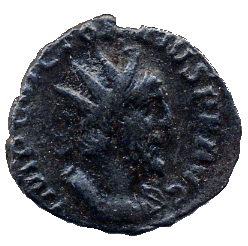
Bust of Victorinus radiate, slightly draped, cuirassed r.; encircled by IMP C VICTORINVS P F AVG

Providentia draped, standing l., holding wand in r. hand over globe and cornucopia in l. hand; encircled by PROVIDENTIA AVG
Marcus Aurelius Claudius, commonly called Claudius II or Claudius Gothicus, ruled the Empire in the two years after the death of Gallienus. He had been one of Gallienus’ officials and was suspected of murdering the emperor. However, he was liked by the Senate, and won an important victory against the Goths in 268 (the Goths were not a real threat to the Empire for a full century afterward). These two factors paved the way for his accession to the throne.
Gothicus was considered to be a strong yet merciful ruler. He was the first emperor to begin the restoration of the Empire after the crises of the third century. He had some success against the secessionist Gallic Empire, but lost Egypt to the Palmyrene Empire of the East. Gothicus may have been able to regain this province, too, but he died of plague in AD 270. The Senate deified him, and after a short interlude wherein Gothicus’ brother Quintillus tried to claim the throne, accepted Aurelian as emperor.
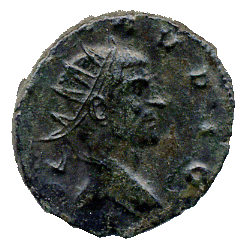
Radiate bust of Claudius Gothicus, r.; encircled by DIVO CLAVDIO

Altar with four panels, each containing pellet, surmounted by flames; encircled by CONSECRATIO; in exergue P
Lucius Domitius Aurelianus was born c. AD 215 in the province of Dacia. He became a successful general under the emperor Gallienus and had a major victory against the Goths at the Battle of Naissus in AD 268. He may have conspired in the murder of Gallienus and perhaps supported Claudius Gothicus’ accession to the throne. After Gothicus’ death, both Senate and army supported Aurelian as emperor.
Aurelian reunited the former provinces of the Empire, including the Palmyrene Empire (reunified in 272) and the Gallic Empire (reunified in 274). He also had to put down several internal revolts, but was successful in retaining the support of the army throughout. But Aurelian’s victories were not solely military. He reformed the imperial coinage, introducing the antoninianus to replace the debased denarius, in order to shore up the suffering economy. He built the Wall of Aurelian around Rome so that the city would be protected from attack. He also instigated some religious reforms. In particular, he built temples to the god of the sun, Sol Invictus, beginning a trend toward monotheism which Constantine later adopted, but in the form of Christianity.
In 275, Aurelian was murdered on his way to war in Persia by officials afraid of his strict disciplinary methods. He was deified soon thereafter.
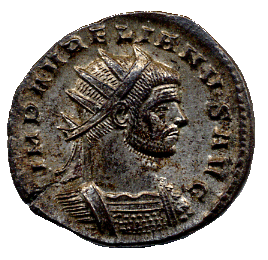
Radiate and cuirassed bust of Aurelian, r.; encircled by IMP AVRELIANVS AVG

Sol, standing r., branch in r. hand and whip in l. hand; l. foot on captive r.; II in field to l.; encircled by ORIENS AVG; in exergue XXIR
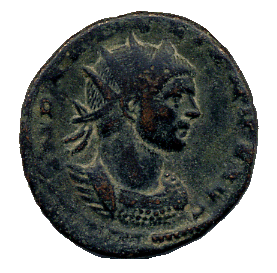
Diademed and cuirassed bust of bearded Aurelian, r.; encircled by IMP C AVRELIANVS AVG

Draped Fortuna, seated facing l. holding rudder in r. hand, cornucopia in l. hand; wheel below seat; encircled by FORTVNA REDVX; in exergue, Q

Radiate and cuirassed bust of Aurelian, r.; encircled by [IMP AV]RELIANVS AVG
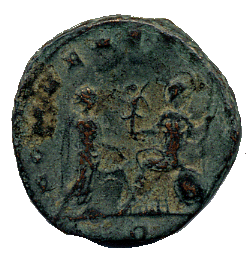
Seated Roma, at right, facing l., shield placed at r., sceptre in l. hand, holding out Victory in r. hand to Aurelian, togate, standing l. extending r. hand; encircled by ROMAE AETER; in exergue Q
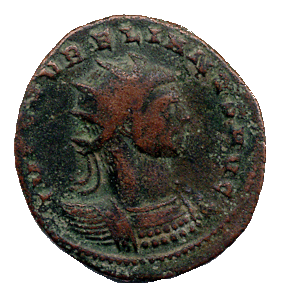
Radiate and cuirassed bust of Aurelian, r.; encircled by IMP C AVRELIANVS AVG
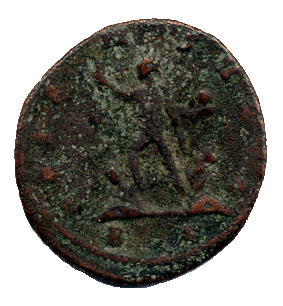
Sol radiate, naked except for cloak hanging from l. arm, advancing with r. hand raised, l. hand behind holding globe; captives on either side seated at his feet; encircled by ORIENS AVG; in exergue R S
Denominations
As has already been mentioned above, the earliest coinage of central Italy, dating from about 269 BC, was the Aes Signatum and the Aes Grave. Around the mid-third century BC, struck silver and bronze coins were introduced, such as the silver didrachm and bronze litrae and half-litrae.
Modifications were made to the coinage before and after the Second Punic War (218-210 BC), and by the end of the second century the principle coin of the Republic was the silver denarius, which was equal to ten bronze asses. During the 140s BC, the denarius came to equal sixteen asses.
The denarius also came to exhibit some unique features such as the denarius serratus with its serrated edge. The reason for this type of coin is highly debated, with some suggesting that the serrated edge proved the purity of the coin, while others say this feature made it difficult for the coins to be clipped for their precious metal.
There was also a silver quinarius (one-half the value of the denarius) and the silver sestertius (one-quarter the value of the denarius).
In the latter period of the Republic, the bronze sestertius came to be the common denomination; prior to this time all amounts were recorded in asses. Gold coins were seldom issued and were not part of the regular coinage of the Republic. After the assassination of Julius Caesar in 44 BC, the gold aureus was struck by and for various disputants.
The emperor Augustus did much to standardize the Roman monetary system. The gold aureus and quinarius were regularly minted; the silver denariusand quinarius were kept as the monetary standard; the sestertius, dupondius, and semis were minted in orichalcum, an alloy of copper and zinc (orichalcum became the standard alloy during the late Republic when the use of the original bronze alloy of copper and tin was dismissed); the as and the quadrans were issued in copper.
Table of Denominations
(from the reign of Augustus to Nero)
Gold Aureus = 25 denarii, 100 sestertii, 400 asses
Quinarius = 12 1/2 denarii, 50 sestertii, 200 asses
Silver Denarius = 4 sestertii, 16 asses
Quinarius = 2 sestertii, 8 asses
Orichalcum Sestertius = 2 dupondii, 4 asses, 16 quadrantes
Dupondius = 2 asses, 8 quadrantes
Copper As = 4 quadrantes
The emperor Nero (AD 54-68) lowered the weight of gold and silver coins and reduced the fineness of the silver. Successive emperors, always in need of money, continued this debasement until, by the reign of the emperor Caracalla (AD 198-217), the denarius was barely 40% silver. Caracalla also introduced the antoninianus, equal in weight to 1 1/2 denarii, but worth two denarii.
By the middle of the third century the antoninianus had superseded the denarius, and had itself been debased to the extent of becoming a copper piece with a slight silvery wash. The only coinage which retained any of its former fineness, though reduced in weight, were the gold denominations. The sestertius, dupondius, and as were issued more or less continuously, but fell out of use when the antoninianus became a bronze coin. The last sestertii of the old style were minted under the emperor Postumus (AD 259-268).
The emperor Diocletian (AD 284-305) regularized the coinage, introducing the silver argenteus, similar to the denarius under Nero, and the follis, a coin of silver-washed bronze resembling the as of the earlier empire. The issue of the antoninianus was discontinued. In place of the aureus, the emperor Constantine (AD 307-337) introduced the solidus, which superseded the aureus as the standard gold coin of the empire. The follis declined in size and weight.
Mints and Minting Authority
Roman Republic
The finances of the Republic which included minting were generally governed by the Senate. Exactly who was responsible for issuing Rome’s earliest coins is uncertain since the coins bear no names, but it is theorized that the consul was responsible for the issue of coinage. Around the time of the institution of the denarius special officials called the tresviri monetales, a board of three moneyers, were placed in charge of the mint.
It was also at this time that symbols and actual names appear on the coins which represent the families of moneyers and the moneyers themselves. These moneyers often selected a coin type which glorified the achievements of a famous ancestor and included his own name, which not only emphasized the prestige of the state, but also advertised the influence of the family to which he belonged, an influence which backed him in his political career. It is also believed that moneyers’ names and symbols were placed on coins in order to provide a safeguard for maintaining quality. Any discrepancy in weight and content of a coin could easily be linked to the moneyer who issued it.
The board of three moneyers was one of the minor offices of the vigintivirate, a board of twenty young men at the beginning of their political careers. Being a member of this board often led to higher offices such as quaestor which if successful led to the consulship. The three moneyers were generally appointed annually and usually struck coins concurrently. Besides the three moneyers at Rome, there were also boards of three located in mints throughout Italy and the provinces and sometimes moneyers from Rome issued coins at provincial mints. The tresviri monetales worked under the general supervision of the quaestor.
Although the tresviri monetales were the authority appointed by the Senate for issuing coinage, after 100 BC we see other minting authorities appearing on coinage such as quaestors, curule aediles, and praetors. There were also issues marked EX S C (Ex Senatus Consulto) or simply S C (Senatus Consulto) which means “by decree of the Senate.” These coins were issued by men with special authority granted by the Senate who do not specify who they are or what their office is.
During the time of the late Republic (after 49 BC) civil wars depleted the authority which the Senate had to issue the coinage. Generals such as Julius Caesar and Pompey the Great, controlling vast armies, now had the authority to strike their own coinage which was used to pay their troops. The Senate’s authority to mint coinage continued to deteriorate which paved the way for Imperial coinage, where the emperor was the official minting authority.
The mints themselves (both Republic and Imperial) often employed freedmen and slaves who were skilled designers, die-engravers, and mechanics for smelting, flan-casting, and striking. There is a lot of uncertainty as to the number of mints and their locations during the Republic. Differences in style and type indicate that more than one mint existed and that they were mostly located in Italy, although mints are known to have existed in the provinces.
The names and titles of the minting authority can often identify a particular mint. Mintmarks and marks of value were also indicative of a specific mint. Mintmarks begin to appear around 124 BC and continue to 56 BC and included numbers, fractions, letters, and symbols which identified work of a particular period and work group within the mint.
Roman Empire
During the Roman Empire, the issue of coins was divided between the emperor and the Senate, with the emperor striking gold and silver coinage and the Senate striking bronze coinage marked by the legend Senatus Consulto. These bronze coins were based on coin types suggested by the emperor. However, bronze coinage could be struck without the legend S C. The little authority which the Senate had over the issue of coinage was in name only.
The structure of the magistrates in charge of managing the mints changed considerably since the times of the Republic. Legends indicate that the tresviri monetales were still being employed as late as the third century AD, but their names disappear completely from the coinage around 4 BC. Senior magistrates directly controlled the working of the mints. The mints of the emperor were under the control of a chief financial minister; provincial mints were controlled by provincial procurators; the Senatorial mints were governed by heads of the Senatorial treasury.
Imperial mints were located in Rome and in provinces such as Spain, Gaul, and Egypt. Evidence found in inscriptions pertaining to the Imperial mint of Trajan indicate that the mint was staffed by freedmen and slaves and was organized on military lines. The Imperial mints were divided into shops known as officinae.
Mintmarks are rare during the first two centuries of the empire, but become common after the reign of Gallienus. The mark identifies the mint and the officina in which a specific coin was issued. The use of mintmarks allowed the emperor to maintain strict control over the actions of mint officials. Coins of improper weight and content could again be easily traced to the people responsible for minting them.
Key Legends
The obverse of imperial coins were monopolized by portraits of the emperor or members of the imperial family. The portrait was usually accompanied by the emperor’s name, or a portion of it, and various titles indicating civil and military distinctions. Some of the most common of these titles and their meanings are listed below. While most of these legends are primarily found on imperial coins, such legends as IMP and S C can also be found on Republican coins.
AVG (Augustus) - The Senate and Roman people conferred this title on Octavian, the emperor Augustus, in 27 BC as an acknowledgment of the services he had rendered to the state. The epithet, which signifies “revered” or “worthy of veneration,” chosen for its dignified but vague significance, became attached to the first emperor, and after him became the title of sovereignty. Most of the emperors took the title as a sign of respect for the memory of the founder of the empire and as the mark of their right to succeed him.
CAESAR (often abbreviated C, CAE, or CAES) - Originally the surname of Julius Caesar and of his adopted son Octavianus, it continued to be the hereditary name of the Julio-Claudians, being transferred to the sons or adopted sons of a Caesar. For example Tiberius was adopted by Augustus and Germanicus was adopted by Tiberius; both men then held the name “Caesar.” After the reign of Nero, the last of the Julio-Claudian emperors, emperors adopted the name of Caesar as well as Augustus as honorific and distinguishing titles although they were not descendants of Julius Caesar and Augustus. Around the time of the emperor Antoninus Pius (AD 137-161), the name Caesar became a title of secondary rank bestowed upon the sons and heirs of the emperor. Eventually, during the reign of Diocletian (AD 284-305), two Caesars were appointed as subordinates to the two Augusti (emperors) and assisted them in governing the empire.
COS (Consul) - Under the Republic the two elected consuls were the chief civil and military magistrates of Rome. Perhaps to preserve some semblance of the old Republic, from vanity, from a desire to appear more exalted, or for some other reason, the emperors assumed the office of the consulship or bestowed it as a sign of favor on a relative or friend. The emperors sometimes held successive consulships, hence on coinage a numeral will often appear after the title.
DIVVS/DIVA/DIVOS (masculine/feminine/plural of “Divine”) - The mark of consecration. This title indicates that the coin was minted after the person’s apotheosis, or deification, and therefore after death. The pagan right of apotheosis involved voting to place a man or woman among the deities. After the apotheosis of Julius Caesar, the coinage of Augustus, Caesar’s adopted son and heir, bears the inscription Divi Filius, “Son of the Divine One,” indicating Augustus’ right to succeed and his filial connection to a deity. The wives of emperors were often deified after death, the first being Livia, wife of Augustus. Augustus himself was treated as a deity during his lifetime, but actual apotheosis occurred after death. Many emperors were deified because of the positive nature of their reigns; some merely so that their successors could endorse their own right to rule. Some, like Tiberius, considered unworthy of the honor, were never deified. The author Seneca, with some wit, wrote the Apocolocyntosis, a satirical description of the pumpkinification (that is, after death he became a pumpkin instead of a god) of the emperor Claudius.
IMP or IM (Imperator) - Commander-in-chief, giving us the English word “emperor.” Under the Republic, the title imperator was applied to generals who had been acclaimed by their troops for a military victory. From the time of Tiberius the title was monopolized by the emperors; they frequently added a repetition number to show on how many occasions they or their deputies were victorious. As general and chief of the Roman legions, the emperor could claim merit for any military victory. In time, it mattered not at all that no victory had been won; the title was an automatic appellation of every emperor.
P P (Pater Patriae) - The title “Father of the Country” was bestowed in 63 BC upon Cicero, who had “saved Rome” from the Catilinarian conspirators. In 2 BC, Augustus was granted the title by the Senate and all the Roman people. He welcomed the title as the crowning of his life’s work. Some emperors appear to have treated this title with more seriousness than other recognized epithets. Tiberius refused the title as did many of his successors, at least until they felt it had been earned. It appears to have been more freely accepted from the time of the emperor Pertinax (AD 193).
PIVS (“Pious”) - Nearly all Roman emperors from the time of Antoninus Pius (AD 138-161) assumed this venerable epithet, which means pious and dutiful. It appears often on coinage in the phrases Pii Filius, Son of the Pious One, and Pius Felix, the Pious and Lucky One.
P M (Pontifex Maximus) - Title of the official head of the Roman religion. The office was accepted by Augustus in 12 BC and was regularly bestowed on subsequent emperors. It carried with it great distinction and reverence, since the Roman religion held an integral role in the functioning of the Roman state.
S C (Senatus Consulto) - “By decree of the Senate.” This phrase intimates that coins were struck by the public authority of the Senate, according to the constitution of the Republic and the laws of the Roman mint. S C is not found on imperial gold and silver money, leading some scholars to believe that the right to mint bronze coinage was permitted to the Senate, while the emperor appropriated to himself the right to mint gold and silver.
TR P, also abbreviated TR POT or TR POTEST (Tribunicia Potestas) - Under the Republic the tribunician power was held by a Tribune of the Plebs, of which there were usually ten. The tribunes were officials whose duty was to defend the lives and property of the plebeians, the common people. Though the tribunes were long the instruments of the Senate, by the first century BC the veto power inherent in the office had caught the attention of individuals seeking power in Rome. Julius Caesar assumed the sacrosanctity of the Tribunate, while Augustus assumed a permanent tribunician power as one of the foundations of his personal power. The other emperors followed his example. On coinage the numbered tribunician power is used to indicate the year of the reign.
Glossary
This glossary outlines some of the common terminology used throughout the descriptions of Roman coins. Other less common terms which are explained in the descriptions of the coins themselves are not included here.
augur - a member of the college of augurs which originally only included three members and was gradually expanded to sixteen. These men were diviners whose duty it was to determine whether the gods were in favor of a proposed action through the observation of signs. These signs were often given by birds. Being a priest in the college was a highly dignified post. The highest ranking members of society, which included members of the imperial family, considered it to be an honor and an advantage to be chosen as a member of this college.
caduceus - a wand or rod entwined at one end by two serpents was an attribute of Mercury, the messenger god. The two serpents represent prudence, while wings sometimes added to the wand were symbols of diligence, both qualities desired in trade and commerce, of which Mercury was the patron deity. The caduceus is often held by female deities such as Pax, Felicitas, and Concordia, in which case it is a symbol of peace and harmony.
cippus - a raised stone which is inscribed to preserve the memory of an important event. These stones were usually small and square in shape, used for both secular and religious purposes.
cistophorus - coins whose name is derived from a cista mystica or mystical box, housing a sacred serpent, used in the worship of the god Dionysus. The term cistophorus was originally given to the person who carried this box. The coins with this title were struck in Asia Minor in recognition of feasts carried out in honor of Dionysus and came to be a symbol for Asia. After Rome’s conquest of Greece, names of Roman magistrates began to appear on them.
cornucopiae - horns filled with fruits, corn-ears, and flowers are a recurring symbol on Roman coins pertaining to abundance, fertility, and happiness. This symbol was sometimes used by moneyers to refer to the abundance of things acquired through money and also by emperors who wanted to advertise the attributes of prosperity and happiness to be a key feature of their reigns.
cuirass - a piece of armor worn to protect the chest; a breast-plate.
eagle - a common symbol of the city of Rome, the eagle was also the minister of Jupiter’s thunder bolts and is often depicted with the god. When seen with another deity, the eagle represents Rome and the blessings which that god or goddess has bestowed upon it. The eagle was also found on Rome’s military standards and was an important figure in consecration ceremonies, where it was released from the summit of a funeral pyre, symbolizing the dead person’s soul being carried up to heaven and therefore becoming a god.
globe - a symbol of the world and the domination of it. Thus it was the sign of the Roman Empire. The globe was also a symbol of eternity since its spherical shape had neither beginning nor end.
jani-form head - a double head derived from the picture of the god Janus. The two heads appear to be looking in different directions: one forward, looking to the future, and one backwards, reflecting on the past. However, where figures other than Janus are presented in this fashion, their symbolic meanings may be somewhat different than that of Janus himself.
laurel wreath or crown - the laurel tree was a symbol for the god Apollo. The leaves of this tree were woven into a crown and bestowed upon commanders as a symbol of their military achievements. Eventually it came to be worn by the emperors as their official head-dress.
lituus - the staff held by an augur while carrying out divinations.
oak wreath or crown - the civic crown made of oak leaves which was originally bestowed upon a man who had saved the life of a citizen during battle and was considered to be a very distinguished honor. During the empire, emperors adorned their own heads with this crown, which marked them as saviors and preservers of the state. The emperor Augustus was the first to wear this crown, since he was believed to have saved Rome from the perils of civil war.
olive branch - the olive tree was believed to have been invented by the goddess Minerva during her contest with Neptune for the possession and name of Athens. The olive branch when held by Minerva herself and other deities is a symbol for peace.
palm branch - a symbol for victory since it was carried by victorious generals during their triumphal processions. It also was a symbol for the permanence of the empire since this tree lived a long time.
patera - a round, shallow dish used by the Romans during religious rituals to either pour libations of wine to the gods or to receive blood from the sacrificial victim. The patera is often depicted on coins being held by gods and goddesses as a symbol of their divine rank or of rites carried out in their honor.
pileus - the cap of liberty often presented with the goddess Libertas or as an attribute of a particular event or reign of an emperor.
pontiff - a priest of the gods and member of the college of pontiffs whose primary functions was to carry out sacrifices to the gods. A pontiff was considered to be in a position of distinction and therefore took precedence before all other magistrates. He often wore a veil (tutulus), pointed cap (apex) and carried a staff (simpulum). The positions of pontiff, which numbered fifteen, were filled by the highest members of society, which included members of the imperial family.
prow - the fore-part of a ship. Frequently found on both Republican and Imperial coins, it was a symbol of Rome’s naval power.
quadriga - a chariot drawn by four horses or elephants, often driven by victorious generals and emperors during triumphal processions. This chariot is often depicted on coins being driven by gods and goddesses, triumphal generals. Sometimes it is simply empty. The quadriga is unanimously known as a symbol for victory and the mark of a triumphal event.
rudder - mechanism in the rear of a ship, used for steering. The rudder of a ship is frequently found on Roman coins and was a symbol of their military power. When seen with the goddess Fortuna it is the means by which she steers the world.
scepter - staff often carried by gods and goddesses as a symbol of their divine power. It also served to represent imperial power during the later empire.
shekel - a denomination of Carthaginian money.
simpulum - a small ladle with a long handle used at sacrifices to pour libations to the gods and to taste the wines that were poured on sacrificial victims. It was one of the insignia of the college of pontiffs.
tessera - a tablet with a handle containing a certain number of points showing that the emperor had given money, corn, or other gifts to the people. It is a symbol of the goddess Liberalitas.
triumph - an honor given to a general in recognition of some exceptional victory over an enemy. A ceremony was carried out in which the victorious general was clothed in a triumphal toga (toga palmata) and the laurel crown. Carrying a palm branch, he rode in a quadriga driven by four white horses, or sometimes elephants, through the city to the capitol. Magistrates also took part in the procession and the quadriga was followed by the spoils of war.
triumvir - a member of a board of three. The Second Triumvirate consisted of three triumvires: Marc Antony, Octavian, and Lepidus. The mints were governed by a board of three known as the triumvires monetales.